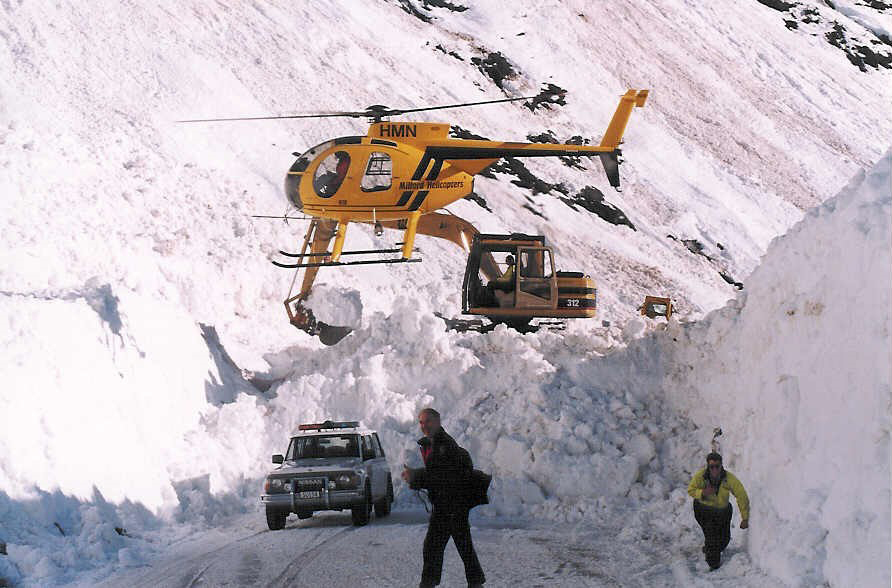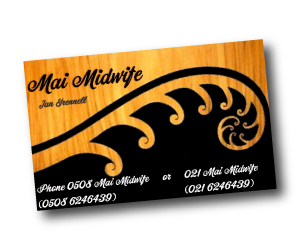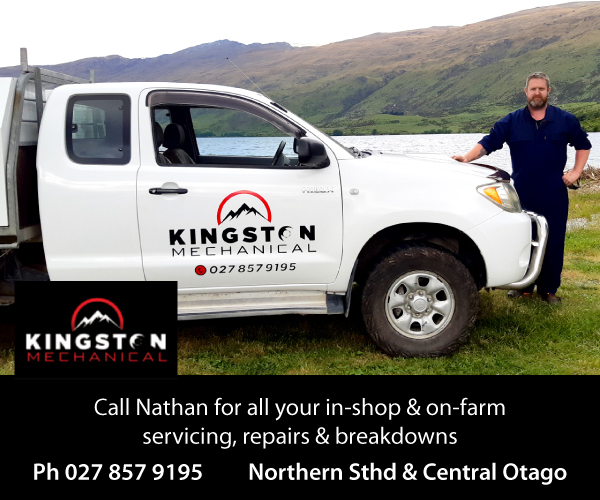Retirement allows for reflection on long career of community service
Jan Ludemann
29 January 2021, 5:00 PM
 Lloyd Matheson has retired as operations manager of Southern Lakes Helicopters. PHOTO: Supplied
Lloyd Matheson has retired as operations manager of Southern Lakes Helicopters. PHOTO: SuppliedLloyd Matheson, the operations manager for Southern Lakes Helicopters and formerly Te Anau’s police sergeant, has retired. Jan Ludemann spoke to him about his long and distinguished service to the area.
“You must be the new cop in town”, this greeting met Lloyd Matheson on his first day on the job in Te Anau back in 1977.
He recalled this welcome while reminiscing on the last 44 years since he and his family arrived in the town, his memories prompted by the former cop’s recent retirement.
The greeting, issued by the late legendary helicopter pilot Bill Black to the town’s newly appoint top cop as he strolled down the main street, was followed in the next breath by an invitation to join the pilot in a welcome drink.
And so, he was introduced to the Fiordland frontier town “as it was in those days”.
The young constable had transferred from his position as police dog handler in Dunedin to a promotion position of charge constable in Te Anau with wife Linda and their then two preschool children Kara and Glenn.
In those days he said, the Te Anau police station was staffed by just two police officers and he was joined at the same time by fellow Dunedin police officer, Tim Henderson.
The pair teamed up for the following 13 years and formed a formidable community policing unit, establishing valuable network connections within the various business and social communities in the pioneering town on the edge of Fiordland.
Advertisement
Advertise on the Southland App
In 1986 the pair were awarded the Queen’s Service Medal recognising their support to the community.
But Mr Matheson was quick to point out that policing was only as good as people in the community made it.
So began his love affair with Te Anau and the wider Fiordland region.
The early years
His early police years in Te Anau were marked by the wild west atmosphere that pervaded the region at the time “Oh I could write a book” he said with a wink.
“It was hard times what with the hydro village population of about 2000 people [during the building of the Manapouri Power Station] and the venison recovery heyday going on and it was also the start of the boom in [Fiordland coastal] lobster fishing and then there was the seasonal influx of shearing gangs [and agricultural contractors] into the [Te Anau] basin to the [Government] Landcorp Farms as well”.
“At times it could be a volatile mixture” he said, especially when bad weather stopped the fishing, flying and shearing work and then all the various workers would gather in the town, usually at Te Anau’s only pub.

Police officer Lloyd Matheson on his beat in Fiordland. PHOTO: Supplied
The Mathesons had only planned to stay in Te Anau until the children had completed primary school, however the town “grew on us” and Mr Matheson continued in the job in Te Anau for a total of 24 years, partnered over the years by a list of such memorable police names as Jim Jamison, Lester Stevens, Gary Tong, Chris Parsons, Barry Hanson, Fraser Jackson, Steve Ditmar, Finn Murphy, Jason Munro, Steve Reed, and watch house officers including Sue Jones, Jane Nicol, Lena Cahill, Barbara Kane and Lyall Daley.
He continued to climb the police career ladder eventually being promoted to Sergeant – Southland Sub-district which made him boss of the area covering Northern Southland.
Of course, the then Matheson preschoolers grew up and have now flown the coop.
Both siblings now live in the North Island, but periodically return to their Fiordland base.
Kara Matheson became a professional photographer and worked as a news photographer for The Southland Times for a time but was more recently involved with the establishment of tourist business Go Orange which is part of Wayfare’s stable of tourist activity businesses.
Glenn Matheson followed his father’s footsteps into the police force and has just completed 21 years police duty. He was stationed for a time in Te Anau as well.
Much of Lloyd Matheson’s police work involved dealing with the human tragedies that often happened in Fiordland’s extreme environment.
Air accidents, carnage on the roads, especially on the Milford Road, fishing boat accidents, farm accidents, mountaineering and tramping accidents were all were part and parcel of the job “and in those days there was no victims’ support so local police had to deal with the emotional carnage as well”.
“You have to understand – my involvement in accidents was not just confined to investigations and reports, but generally I was friends with the victims and their families as well.”
Advertisement
Advertise on the Southland App
During his police career, several aircraft completely disappeared in Fiordland with no trace.
He recalled the disappearance of a Cessna 180 in August 1978 on a fishing trip to Big Bay with four passengers on board and a Cherokee Six that disappeared in December 1978 with seven on board.
Mr Matheson still has an interest in bringing closure to those investigations “it’s a bit like an unsolved crime to me”.
Community involvement
Over the years the Matheson Family naturally became involved in the development of the region by living and working and socialising in the town.
Wife Linda supported Lloyd in his work but also made her own mark in the small community working at various jobs such as medical centre receptionist and land agent. She and Lloyd also worked as a team for the Police Welfare Association taking care of the association’s holiday homes and assets in Te Anau.
They both became involved in voluntary work and took on various governance roles particularly at the primary and secondary schools.
Mr Matheson police role meant he was particularly involved with volunteer groups such as Search and Rescue (SAR) where he was the police coordinator, and with the local ambulance service.
Mr Matheson said he was proud to be part of a caring community.
He credited the strength of the local community including service clubs Rotary International and Lions, businesses Meridian and Downers and philanthropic individuals for stepping up and fundraising the cost of most of the rescue gear used in Fiordland.
Within the police he held various positions on the support services – was a committee member and the chairman of the Southland District Police Association (SDPA) which, he said, was basically the welfare side of police.
Advertisement
Advertise on the Southland App
He was appointed chairman of the Otago Rural Police Association (ORPA) which represents the rural police community from Oamaru south.
This was followed by 12 years as Director of the National Police Association (NPA), one of seven representatives from each of New Zealand’s seven police districts.
NPA deals with internal policing issues to ensure fair processes for its members and manages a welfare fund to provide services such a legal representation if necessary, he said.
Southern Lakes Helicopters
The idea of Mr Matheson working for Southern Lakes Helicopters was floated by company owner and pilot Sir Richard Hayes in 1999 and it sat as an idea with the policeman for three years while he mulled over the pros and cons of the proposed change, but in the end, it seemed a natural progression and the right thing to do.
So, in 2002, with a total of 34 years of policing under his belt (25 in Te Anau) he took early retirement from the police and took up a job offer from Sir Richard at his Te Anau based company Southern Lakes Helicopters as Operations Compliance Manager (OCM) a position he stayed in, in its various forms, until his recent retirement late last year.
There was a hiccup in his appointment right at the beginning with Civil Aviation Authority (CAA) requiring the position be filled by a commercially licensed pilot who would also be company’s Chief Pilot.
Mr Matheson was not a helicopter pilot so there it was, police job finished but was now not qualified to take up the new job.
To comply, the company changed the job title to Occurrences Investigator, but he unofficially remained Operations Compliance Manager.
“I was dumped in the deep end on my first day,” he said, with a CAA safety audit.
The audit produced 21 “findings” meaning anomalies that could compromise the safe operation of the company.
“They were just small things that had been simply overlooked” so he set about implementing a regimen and work culture of best practice that permeated the whole company philosophy and operation and meant it became, and is still now most often, ahead of health and safety minimum requirements.
“The company is now viewed by CAA as an example of best practice”.
He was pleased to say that by the next audit there were no “findings” at all and he still has a message from Sir Richard congratulating him on a “bloody good job well done”.
Advertisement
Advertise on the Southland App
The Te Anau waterfront-based company at that time operated just two helicopters, an Airbus AS350 (Squirrel) and a Hughes 500, flown by pilots Sir Richard Hayes and Rod Hall-Jones, and employed receptionist Allison Gibbs.
He said the job changed enormously over the years with the company growing from a single operator to two fully air operator certified companies when Queenstown based business, Heliworks, was established.
Mr Matheson’s workload increased exponentially, and he was soon joined by Richard Mills who filled the role of Quality Assurance Manager for both companies.
On top of his role as OCM, he also brought to the job experience as an authorised Search and Rescue (SAR) winch operator on rescue helicopters and was often called out on helicopter SAR operations, which nearly always involved recovering people with serious and/or deadly injuries in very dicey weather and precarious locations.
“The SAR operation became a big part of the job.”
He lauded the enormous investment Southern Lakes Helicopters committed into purchasing and maintaining the rescue winch.
“It was originally owned by the Lakes District Air Rescue Trust (LDART)” but eventually climbing costs of compliance and maintenance and liability meant the trust could no longer carry the burden.”
A complete overhaul of the winch is required every five years regardless of use, so in 1994 the winch ownership was transferred to Southern Lakes Helicopters.
“The compliance costs are enormous.”
For example, the overhaul costs have risen from $56,000 in 1994 to more than $100,000 today, he said.
The Red Tape
Working for the helicopter company meant that he also took on a wider bureaucratic workload becoming involved in governance roles supporting the wider aviation industry, particularly in determining air access to Fiordland and landing rights.
During the next 18 years Mr Matheson was variously appointed or elected to several lobby groups in particular acting in a liaison role to the Fiordland Aviation Group, which became a party to legal challenges against Environment Southland over proposed changes mooted to restrict commercial landings outside the Fiordland National Park.
The action involved a lot of submissions and court hearings and was very costly but in the end the court decided that the total number landings be reduced from 47 to 14.
Advertisement
Advertise on the Southland App
He then become involved with the Queenstown/Milford Sound Air Users group (QMSAUG), a management coalition formed to ensure safe use of the restricted air space after a midair collision over Milford Sound involving two tourist aircraft with the loss of seven passengers.
He previously helped the group to challenge and reverse changes proposed when the last Fiordland National Park 10-year plan was opened for submissions.
Changes proposed at that time would have restricted the number of landings at Milford Sound, which would have severely affected tourist air companies dependent on the access there.
A new 10-year plan is currently under consideration and the air users’ group is facing similar challenges in the new plan’s proposals.
His job also meant he became involved in the national Aviation Industry Association (AIA) initially as a representative member on the Helicopter Association – one of nine divisions of the AIA.

Lloyd Matheson pictured at the 2016 New Zealand Aviation Industry Association conference. PHOTO: Supplied
Mr Matheson was then elected chairman of the group committee, followed by election to vice president of the AIA and eventually president, a role he currently holds (the term was extended when last year’s AGM was cancelled because of Covid-19 restrictions).
Changes
The biggest changes he had seen during his time in the aviation industry had to be in the area of health and safety, Mr Matheson said.
Modern technology, locator beacons, night vision goggles, implementation of constantly revised safety systems.
He said “the buy-in by management has been critical to the implementation of safety systems” …. “we are now the ambulance at the top of the cliff instead of at the bottom”.
His job has seen him visit Antarctica, the Grand Canyon in USA and in 2019 he travelled to Fiji where he participated in an eco-challenge with Bear Grylls, providing logistical support as a winch crewman to the event.
Southern Lakes Helicopters supplied two winch-capable rescue helicopters in Fiji, a BK117 used exclusively for Bear Grylls and a Squirrel, which was used in a rescue capacity.
Mr Matheson said the helicopter company had been involved in two previous Eco-challenges, the most recent in 2001 in New Zealand and prior to his change of job, but he took special leave to join the support crew there.
The worst incident in his career? The company’s high-profile helicopter ditching into the sea at night near the sub-Antarctic Auckland Islands on April 22, 2019, while on a medical evacuation mission.
Advertisement
Advertise on the Southland App
The three crew on board miraculously survived the crash and were able to swim to the nearest land to wait rescue.
An official report following a Transport Accident Investigation Commission (TAIC) inquiry into the accident is still to be released.
Retirement
It is hard to imagine Lloyd Matheson retired and it’s a vision he has trouble seeing as well.
Although the idea of retiring had been in the pipeline, it came sooner than he had hope for.
“I’m probably a COVID-19 statistic.”
Along with most businesses, especially in Fiordland, the helicopter company had to change in the wake of the economic downturn caused by the lockdown and border closure, and retrenchment meant his job was no longer tenable.
He has no plans beyond seeing out his term as president of the AIA which ends in June.
But his knowledge and experience are unlikely to go to waste given his prominence in the aviation industry.
However, the suggestion of a book was met with a shrug of the shoulders but, he said, he’s not one to be sitting around doing nothing, so watch this space.
AG | TRADES & SUPPLIES








